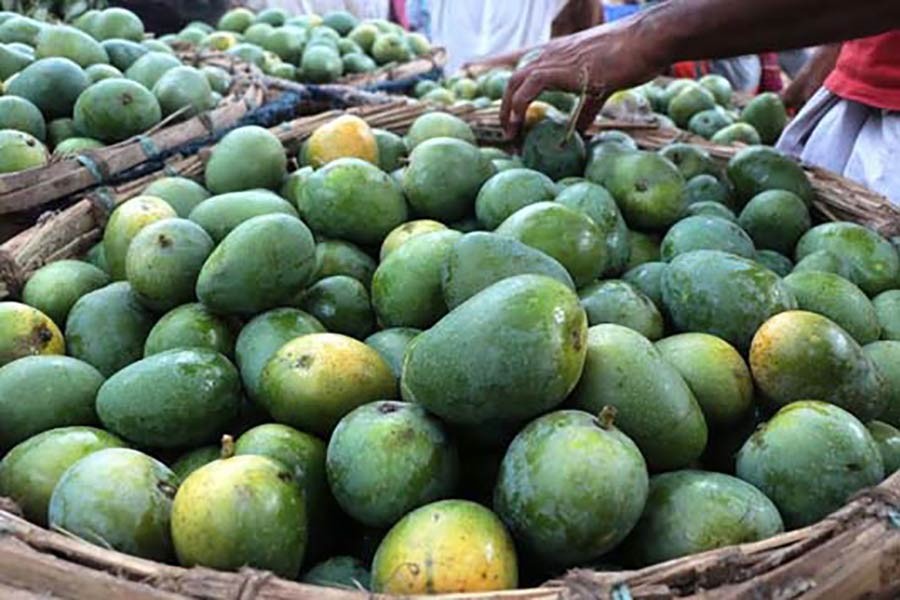Popular belief has it that Bangladesh, India and Pakistan are the largest producers of the delicious sweet fruit --- mangoes. In fact, many other countries grow this fruit, which is termed the 'king of fruits' in Bangladesh. Prominent among mango-growing countries are China, Thailand, Mexico, Indonesia and Brazil. All of them, except Bangladesh, have long been exporting the fruit to overseas countries, especially those in Europe and North America. Of late, Vietnam has obtained licence from the US authorities to export mangoes to that country. A popular Bangladeshi mango was awarded early this year the GI (Geographical Indication) tag from the World Intellectual Property Organisation. The mango is Khirshapat, popularly known as Himsagar. Thanks to this recognition, the country can now utilise the opportunities opened to it for exporting this and other mangoes to interested countries. Bangladesh grows around a dozen types of this summer fruit in the country's southwestern and northern districts. The country has the capability to produce 1.0 million tonnes of mango a year.
Bangladesh's earlier track record of exporting frozen fish and edible items like vegetables to Europe was not encouraging. However, over the years the condition began to be favourable to it. Largely buoyed by the GI tag for one of its mangoes, the country's exporters this year began preparing to export the fruit overseas. In the recent years, the market has witnessed stiff competition. Many traditional mango-exporting countries continue to dominate the market. Braving this adverse condition, Bangladesh entered the market, humbly at that, back in 2015. It exported 800 tonnes of mango to European countries that year. The quantity fell to 300 tonnes the following year. The decline was singularly blamed on the stringent safety measures in the importing countries.
As a new entrant to the mango export market, Bangladesh should have been aware of some basic prerequisites for the export. As per internationally applied rules for fruit export, traders have to strictly abide by the requirements of phytosanitary and quarantine certifications relating to the health of the plants from specific departments in the exporting countries. Apparently the exporters were unaware of the rules. Thanks mainly to this deficiency, 15 consignments of Bangladeshi vegetables were cancelled by the European countries earlier.
When it comes to the export of mangoes, Bangladesh can reap the benefits of a number of advantages, observes the FAO (Food and Agriculture Organisation). When the fruit ripen in the country, no mangoes from other countries are found in the overseas market. Moreover, Bangladeshi mangoes enjoy a special place in the UK. The buyers of mangoes in that country consider the country's fruit to be the most delicious in the world. In order to retain this preference for the country's mangoes among the buyers in the UK and some other countries, Bangladesh should keep in mind a vital imperative: Safe mango producing, harvesting and storage facilities. Drawbacks besetting the agriculture department coupled with the farmers' ignorance lead to disappointing situations.
A vital aspect related to exportable mango production comprises scientific mango ripening and preservation facilities. Due to the lack of mango storage infrastructure in the private sector, huge quantities of mangoes develop blights and lose their exportability. Only a full-scale government support to help develop this facility can create an atmosphere conducive to export of healthy mangoes.
The domestic market once used to be flooded by chemically treated mangoes. Thanks to frequent anti-adulteration drives, the dominance of these hazardous mangoes has declined in the local market. When it comes to export of mangoes, the very thought of using chemicals for the fruit's ripening and longer edibility should be declared an anathema. In-depth scrutiny by mango cultivation experts has come up with heartening facts. According to it, farmers and wholesalers these days do not use calcium carbide or formalin for ripening the fruit. Instead they have turned to Ethephon in required quantity. This practice is said to be not harmful to human health.
In the bygone days, it was chiefly the fibrous sweet-sour native mangoes that would cater to the people's love and passion for the age-old favourite fruit. The local mango market used to be dominated by 'Fazli'and a few varieties of sweet and aromatic mangoes. The revolution in growing improved varieties of mango began with the endeavours of a section of agriculturalists. The growers also did not lag behind. Besides setting up new orchards exclusively for growing delicious and improved varieties of the fruit, a few of them engaged themselves in the innovation of the types of mangoes not seen before in the country. Their efforts to grow hybrid and all-season mangoes received much impetus from a section of venturesome horticulturists.
A new chapter has opened in the Bangladesh mango production. It undoubtedly is one of the most significant developments in the country's fruit sector. The export potential of Bangladesh mangoes is enormous. Upon emerging as the 7th largest mango-producing country in the world, there are no reasons for it being not included in the traditional mango exporting countries. For this to happen, the country should stress the export prerequisites. Even distantly veiled compromises will deprive the nation of a new cash crop.


